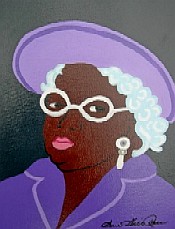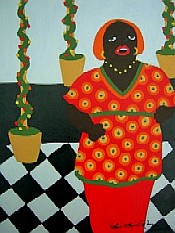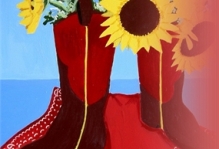 “I don’t want to compete with NW Regionalism. I want to paint what my roots are, which is why I came back to these Southern Tradition Paintings. When I first started the Southern Reflection Series, I did two diptychs that were my memories of Shreveport and they were in watercolor, before I decided to try acrylics. One was a scene I saw everyday, the black lady sitting on the porch in the metal chair. I can still remember and see her sitting in that green chair with a baby on her lap as though it was yesterday. And the name of the street is Snow Street and there is a dead end sign right on the corner. There are parts of the South that I will not forget…”
“I don’t want to compete with NW Regionalism. I want to paint what my roots are, which is why I came back to these Southern Tradition Paintings. When I first started the Southern Reflection Series, I did two diptychs that were my memories of Shreveport and they were in watercolor, before I decided to try acrylics. One was a scene I saw everyday, the black lady sitting on the porch in the metal chair. I can still remember and see her sitting in that green chair with a baby on her lap as though it was yesterday. And the name of the street is Snow Street and there is a dead end sign right on the corner. There are parts of the South that I will not forget…”
Partial memories, partially published recollections, trivial events never forgotten… These are the images that work themselves into Sue’s current paintings. Subject matter isolated by vibrant colors. Her settings are sparse but still depictive in uncomplicated terms.
“…and if you’ve ever read Southern authors you can relate without ever having been there…their descriptive words conjure up visions that mix with my memories of childhood like, riding in the mule cart in East Texas… steaming swamp moss dripping from the cypress trees… little old ladies playing bingo. When you get to a certain age you really want to remember more what’s good about life than what’s bad about life. Maybe I am trying to depict that idea with a tinge of humor.”
 “Simple and mundane pleasures are the best.” There are certain Southern Traditions that are just funny and stand out in her memory. Church ladies, preachers, grounds keepers, fish cleaners, cooks, laundry on the clothesline, hunting and fishing in East Texas, girls on sidewalks with their Hula-Hoops, drum majors, marching high school bands, or the flow of the lazy river, all are a part of life that is constant discovery; amusement and amazement.
“Simple and mundane pleasures are the best.” There are certain Southern Traditions that are just funny and stand out in her memory. Church ladies, preachers, grounds keepers, fish cleaners, cooks, laundry on the clothesline, hunting and fishing in East Texas, girls on sidewalks with their Hula-Hoops, drum majors, marching high school bands, or the flow of the lazy river, all are a part of life that is constant discovery; amusement and amazement.
“I think that all of this is right now and part of the past. This series is a culmination of all these experiences coming together. In answer to the question I am often asked, “Why do you paint images of Afro-Americans?” … because I spent 30 years of my life in a town that was more than half Black. Like family or friends, they have become a part of my roots; they have all become a part of me now.”

